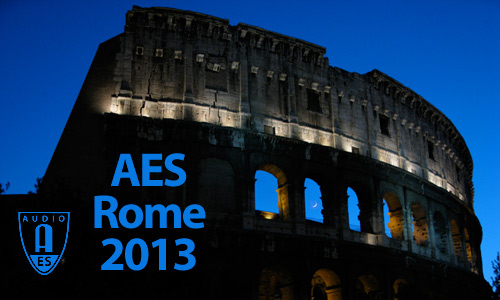
AES Rome 2013
Poster Session P13
P13 - Room Acoustics
Monday, May 6, 10:00 — 11:30 (Foyer)
P13-1 The Effect of Playback System on Reverberation Level Preference—Brett Leonard, McGill University - Montreal, Quebec, Canada; The Centre for Interdisciplinary Research in Music Media and Technology - Montreal, Quebec, Canada; Richard King, McGill University - Montreal, Quebec, Canada; The Centre for Interdisciplinary Research in Music Media and Technology - Montreal, Quebec, Canada; Grzegorz Sikora, Bang & Olufsen Deutschland GmbH - Pullach, Germany
The critical role of reverberation in modern acoustic music production is undeniable. Unlike many other effects, reverberation’s spatial nature makes it extremely dependent upon the playback system over which it is experienced. While this characteristic of reverberation has been widely acknowledged among recording engineers for years, the increase in headphone listening prompts further exploration of these effects. In this study listeners are asked to add reverberation to a dry signal as presented over two different playback systems: headphones and loudspeakers. The final reverberation levels set by each subject are compared for the two monitoring systems. The resulting data show significant level differences across the two monitoring systems.
Convention Paper 8886 (Purchase now)
P13-2 Adaptation of a Large Exhibition Hall as a Concert Hall Using Simulation and Measurement Tools—Marco Facondini, TanAcoustics Studio - Pesaro (PU), Italy; Daniele Ponteggia, Studio Ing. Ponteggia - Terni (TR), Italy
Due to the growing demand of multifunctional performing spaces, there is a strong interest in the adaptation of non-dedicated spaces to host musical performances. This leads to new challenges for the acousticians with new design constraints and very tight time frames. This paper shows a practical example of the adaptation of the “Sala della Piazza” of the “Palacongressi” of Rimini. Thanks to the combined use of prediction and measurement tools it has been possible to design the acoustical treatments with a high degree of accuracy, reaching all targets and at the same time respecting the tight deadlines.
Convention Paper 8887 (Purchase now)
P13-3 Digital Filter for Modeling Air Absorption in Real Time—Carlo Petruzzellis, ZP Engineering S.r.L. - Rome, Italy; Umberto Zanghieri, ZP Engineering S.r.L. - Rome, Italy
Sound atmospheric attenuation is a relevant aspect of realistic space modeling in 3-D audio simulation systems. A digital filter has been developed on commercial DSP processors to match air absorption curves. This paper focuses on the algorithm implementation of a digital filter with continuous roll-off control, to simulate high frequency damping of audio signals in various atmospheric conditions, along with rules to allow a precise approximation of the behavior described by analytical formulas.
Convention Paper 8888 (Purchase now)
P13-4 Development of Multipoint Mixed-Phase Equalization System for Multiple Environments—Stefania Cecchi, Universitá Politecnica della Marche - Ancona, Italy; Marco Virgulti, Universitá Politecnica della Marche - Ancona, Italy; Stefano Doria, Leaff Engineering - Ancona, Italy; Ferruccio Bettarelli, Leaff Engineering - Ancona, Italy; Francesco Piazza, Universitá Politecnica della Marche - Ancona (AN), Italy
The development of a mixed-phase equalizer is still an open problem in the field of room response equalization. In this context, a multipoint mixed-phased impulse response equalization system is presented taking into consideration a magnitude equalization procedure based on a time-frequency segmentation of the impulse responses and a phase equalization technique based on the group delay analysis. Furthermore, an automatic software tool for the measurement of the environment impulse responses and for the design of a suitable equalizer is presented. Taking advantage of this tool, several tests have been performed considering objective and subjective analysis applied in a real environment and comparing the obtained results with different approaches.
Convention Paper 8889 (Purchase now)
P13-5 Acoustics Modernization of the Recording Studio in Wroclaw University of Technology—Magdalena Kaminska, Wroclaw University of Technology - Wroclaw, Poland; Patryk Kobylt, Wroclaw University of Technology - Wroclaw, Poland; Bartlomiej Kruk, Wroclaw University of Technology - Wroclaw, Poland; Jan Sokolnicki, Wroclaw University of Technology - Wroclaw, Poland
The aim of this paper is to present results of the acoustic modernization at the Wroclaw University of Technology recording studio. During the project realization, the focus is on the problem arising in one part of the recording studio—the so-called flutter echoes phenomenon. To minimize this effect we present a several-stage process in which the studio is accommodated to expect this occurrence. The first step was to make some measurements of acoustic properties in the room with the concentration on the previously mentioned effect. Next, a one-dimension diffuser was designed and placed in the phenomenon incidence. The last stage of the research was an acoustic measurement after modification and comparison with the properties before the changes.
Convention Paper 8890 (Purchase now)
P13-6 Accurate Acoustic Echo Reduction with Residual Echo Power Estimation for Long Reverberation—Masahiro Fukui, NTT Corporation - Musashino-shi, Tokyo, Japan; Suehiro Shimauchi, NTT Corporation - Musashino-shi, Tokyo, Japan; Yusuki Hioka, University of Canterbury - Christchurch, New Zealand; Hitoshi Ohmuro, NTT Corporation - Musashino-shi, Tokyo, Japan; Yoichi Haneda, The University of Electro-Communications - Chofu-shi, Tokyo, Japan
This paper deals with the problem of estimating and reducing residual echo components that result from reverberant components beyond the length of FFT block. The residual echo reduction process suppresses the residual echo by applying a multiplicative gain calculated from the estimated echo power spectrum. However, the estimated power spectrum reproduces only a fraction of the echo-path impulse response and so all the reverberant component are not considered. To address this problem we introduce a finite nonnegative convolution method by which each segment of echo-impulse response is convoluted with a received signal in a power spectral domain. With the proposed method, the power spectra of each segment of echo-impulse response are collectively estimated by solving the least-mean-squares problem between the microphone and the estimated-residual-echo power spectra. The performance of this method was demonstrated by simulation results in which speech distortions were decreased compared with the conventional method.
Convention Paper 8891 (Purchase now)
